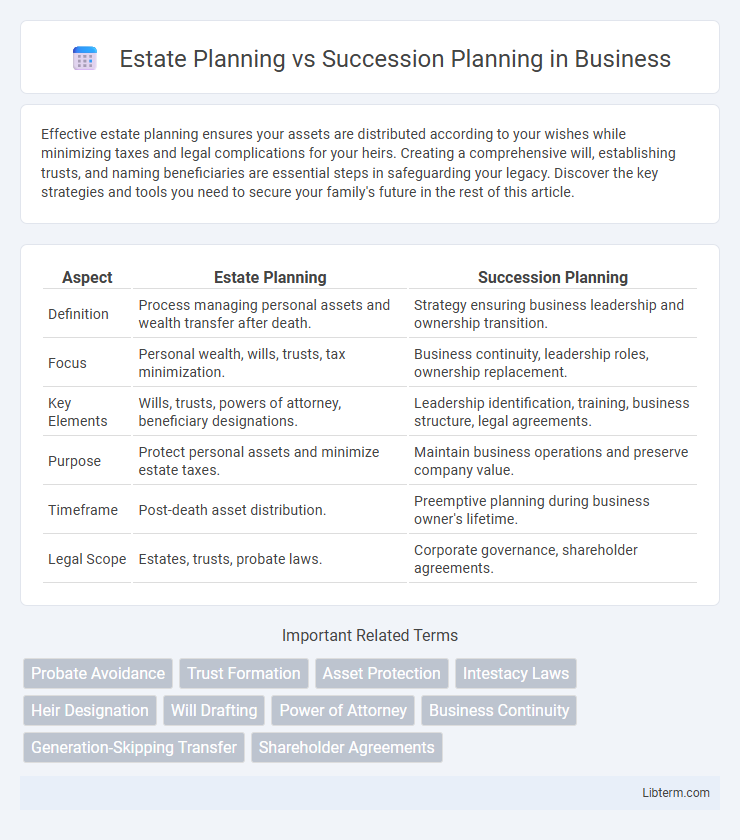Effective estate planning ensures your assets are distributed according to your wishes while minimizing taxes and legal complications for your heirs. Creating a comprehensive will, establishing trusts, and naming beneficiaries are essential steps in safeguarding your legacy. Discover the key strategies and tools you need to secure your family's future in the rest of this article.
Table of Comparison
| Aspect | Estate Planning | Succession Planning |
|---|---|---|
| Definition | Process managing personal assets and wealth transfer after death. | Strategy ensuring business leadership and ownership transition. |
| Focus | Personal wealth, wills, trusts, tax minimization. | Business continuity, leadership roles, ownership replacement. |
| Key Elements | Wills, trusts, powers of attorney, beneficiary designations. | Leadership identification, training, business structure, legal agreements. |
| Purpose | Protect personal assets and minimize estate taxes. | Maintain business operations and preserve company value. |
| Timeframe | Post-death asset distribution. | Preemptive planning during business owner's lifetime. |
| Legal Scope | Estates, trusts, probate laws. | Corporate governance, shareholder agreements. |
Understanding Estate Planning: Key Concepts
Estate planning involves creating a comprehensive strategy to manage and distribute an individual's assets during their lifetime and after death, focusing on wills, trusts, power of attorney, and healthcare directives. Key concepts include minimizing estate taxes, ensuring asset protection, and providing clear instructions for beneficiaries to avoid probate complications. This process secures financial stability for heirs and aligns asset distribution with the individual's wishes while maintaining legal compliance.
Defining Succession Planning: An Overview
Succession planning involves identifying and preparing future leaders to ensure business continuity, particularly in family-owned enterprises and corporations. It focuses on the strategic transfer of management roles and decision-making responsibilities rather than just asset distribution. This proactive approach secures organizational stability by aligning leadership development with long-term business goals.
Core Differences Between Estate and Succession Planning
Estate planning centers on managing and distributing an individual's assets and liabilities after death, ensuring the orderly transfer of property through wills, trusts, and probate processes. Succession planning focuses on identifying and preparing successors for leadership roles within a business or organization, emphasizing continuity and strategic transition. The core difference lies in estate planning's asset distribution for personal legacy, while succession planning targets operational continuity and leadership transition in business contexts.
Goals and Objectives of Estate Planning
Estate planning aims to efficiently manage and distribute an individual's assets during their lifetime and after death, ensuring financial security for beneficiaries and minimizing tax liabilities. It focuses on creating wills, trusts, power of attorney, and healthcare directives to safeguard assets and provide clear instructions. The primary objectives include protecting wealth, reducing estate taxes, avoiding probate, and maintaining family harmony.
Goals and Objectives of Succession Planning
Succession planning aims to ensure the seamless transfer of leadership, maintaining business continuity and preserving value for future generations. It focuses on identifying and developing internal personnel with the potential to fill key leadership roles, aligning talent management with long-term strategic goals. The primary objective is to minimize disruptions, sustain organizational stability, and support the growth and legacy of the business over time.
Legal Tools in Estate Planning
Legal tools in estate planning primarily include wills, trusts, powers of attorney, and advance healthcare directives, which ensure asset distribution and decision-making authority according to an individual's wishes. Unlike succession planning, which focuses on the strategic transfer of business ownership and leadership, estate planning tools are designed to manage personal assets and provide clarity on legal and financial matters after death or incapacitation. Proper use of these legal instruments minimizes probate complications, reduces estate taxes, and safeguards beneficiaries' interests.
Strategies in Succession Planning for Businesses
Strategies in succession planning for businesses include identifying and developing internal talent, creating leadership development programs, and establishing clear communication channels for smooth transitions. Implementing formalized succession plans with defined roles and timelines ensures business continuity and mitigates risks associated with leadership changes. Leveraging tools like mentorship, performance assessments, and contingency planning enhances preparedness for unexpected departures or retirements.
Benefits of Estate Planning for Families
Estate planning provides families with clear directives for asset distribution, minimizing conflicts and legal disputes among heirs. It ensures financial security by protecting wealth through trusts, wills, and tax-efficient strategies, preserving family legacies for future generations. Proper estate planning also facilitates smoother transfer of assets, reduces probate costs, and offers peace of mind by addressing healthcare and guardianship decisions.
Challenges in Succession Planning for Entrepreneurs
Entrepreneurs face unique challenges in succession planning due to the complexity of transferring business ownership and leadership while maintaining operational continuity. Valuing intangible assets, aligning family members' interests, and preparing successors with adequate business expertise often complicate the succession process. Ensuring legal compliance, minimizing tax liabilities, and fostering clear communication throughout the transition are critical yet demanding aspects for entrepreneurial succession planning.
Choosing the Right Planning Approach for Your Needs
Choosing the right planning approach depends on your specific goals: estate planning primarily addresses the distribution of your assets after death, ensuring legal transfer and minimizing taxes, while succession planning focuses on seamlessly transferring leadership and ownership of a business to the next generation or new management. For individuals with significant business interests, integrating succession planning with estate planning creates a comprehensive strategy that protects both personal wealth and business continuity. Evaluating factors such as asset types, family dynamics, tax implications, and long-term business objectives helps determine whether estate planning, succession planning, or a combination of both best suits your needs.
Estate Planning Infographic

 libterm.com
libterm.com